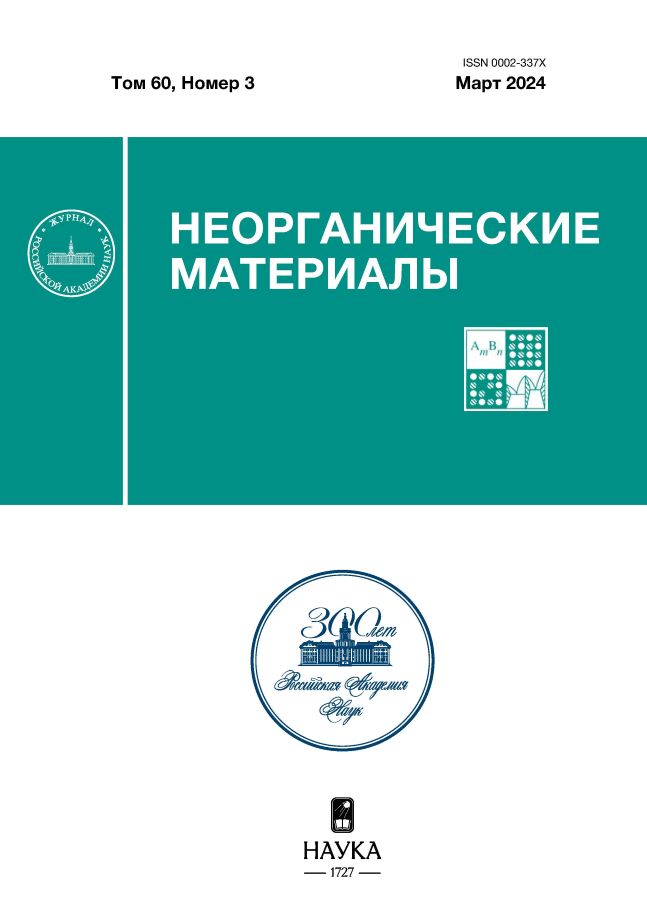Механизм реакции h2 на поверхности In2O3 (011) с предадсорбированной молекулой кислорода
- 作者: Курмангалеев К.С.1, Михайлова Т.Ю.2, Трахтенберг Л.И.1,3
-
隶属关系:
- Федеральный исследовательский центр химической физики им. Н.Н. Семенова Российской академии наук
- Институт общей и неорганической химии им. Н.С. Курнакова Российской академии наук
- Московский государственный университет им. М.В. Ломоносова
- 期: 卷 60, 编号 3 (2024)
- 页面: 331-335
- 栏目: Articles
- URL: https://cardiosomatics.ru/0002-337X/article/view/668496
- DOI: https://doi.org/10.31857/S0002337X24030091
- EDN: https://elibrary.ru/LKPXMR
- ID: 668496
如何引用文章
详细
Модифицированным методом упругой ленты (CI-NEB) рассчитаны энергии активации реакции H2 с предадсорбированной на поверхности In2O3(011) молекулой кислорода с образованием молекулы воды в одном случае и гидроксильной группы в другом. При этом один гидроксил образуется в результате связывания ОН с поверхностным атомом металла, а другой – за счет связи водорода с решеточным кислородом. Вычисления показывают, что энергии активации этих реакций имеют близкие величины: 0.99 и 0.98 эВ, однако термодинамически выгодным является гидроксилирование поверхности.
全文:
作者简介
К. Курмангалеев
Федеральный исследовательский центр химической физики им. Н.Н. Семенова Российской академии наук
编辑信件的主要联系方式.
Email: f7033@mail.ru
俄罗斯联邦, Москва
Т. Михайлова
Институт общей и неорганической химии им. Н.С. Курнакова Российской академии наук
Email: f7033@mail.ru
俄罗斯联邦, Москва
Л. Трахтенберг
Федеральный исследовательский центр химической физики им. Н.Н. Семенова Российской академии наук; Московский государственный университет им. М.В. Ломоносова
Email: f7033@mail.ru
俄罗斯联邦, Москва; Москва
参考
- Sayago I., Terrado E., Lafuente E., Horrillo M.C., Maser W.K., Benito A.M., Navarro R., Urriolabeitia E.P., Martinez M.T., Gutierrez J. Hydrogen Sensors Based on Carbon Nanotubes Thin Films // Synth. Met. 2005. V. 148. P. 15–19. https://doi.org/10.1016/j.synthmet.2004.09.013
- Kumar M., Ramaprabhu S. Palladium Dispersed Multiwalled Carbon Nanotube Based Hydrogen Sensor for Fuel Cell Applications // Int. J. Hydrogen Energy. 2007. V. 13. P. 2518–2526. https://doi.org/10.1016/j.ijhydene.2006.11.015
- Ikim M.I., Gerasimov G.N., Gromov V.F., Ilegbusi O.J., Trakhtenberg L.I. Phase Сomposition, Сonductivity, and Sensor Properties of Cerium-Doped Indium Oxide // Nano Mater. Sci. 2023. V. 24. № 2. P. 1570. https://doi.org/10.1016/j.nanoms.2023.09.001
- Kumar M., Mehta B.R., Singh V.N., Chatterjee R., Milikisiyants S., Lakshmi K.V., Singh J.P. The Role of Stoichiometry of Indium and Oxygen on Gas Sensing Properties of Indium Oxide Nanostructures // Appl. Phys. Lett. 2010. V. 96. № 12. P. 123114:1–3. https://doi.org/10.1063/1.3371717
- Walsh A. Surface Oxygen Vacancy Origin of Electron Accumulation in Indium Oxide // Appl. Phys. Lett. 2011. V. 98. P. 261910:1–3. https://doi.org/10.1063/1.3604811
- Lany S., Zakutayev A., Mason T.O., Wager J.F., Poeppelmeier K. R., Perkins J.D., Berry J.J., Ginley D.S., Zunger A. Surface Origin of High Conductivities in Undoped In2O3 Thin Films // Phys. Rev. Lett. 2012. V. 108. P. 016802:1–5. https://doi.org/10.1103/physrevlett.108.016802
- Lany S., Zunger A. Dopability, Intrinsic Conductivity, and Nonstoichiometry of Transparent Conducting Oxides // Phys. Rev. Lett. 2007. V. 98. № 4. P. 045501:1–4. https://doi.org/10.1103/PhysRevLett.98.045501
- Posada-Borbón A., Grönbeck H. Hydrogen Adsorption on In2O3(111) and In2O3(110) // PCCP. 2020. V. 22. P. 16193–16202. https://doi.org/10.1039/D0CP01749C
- Chen Y., Wang X., Shi C., Li L., Qin H., Hu J. Sensing Mechanism of SnO2(110) Surface to H2: Density Functional Theory Calculations // Sens. Actuators, B. 2015. V. 220. P. 279–287. https://doi.org/10.1016/j.snb.2015.05.061
- Posada-Borbón A., Grönbeck H. CO2 Adsorption on Hydroxylated In2O3(110) // PCCP. 2019. V. 21. № 39. P. 21698–21708. https://doi.org/10.1039/c9cp04097h
- Li M., Zhu H., Wei G., He A., Liu Y. VOCs Gas Sensing Properties on SnO2 (110) Surface with Dissociated Oxygen Species Pre-adsorbed: Experiments and DFT Analysis // J. Mater. Sci.: Mater. Electron. 2019. V. 30. P. 19625–19638. https://doi.org/10.1007/s10854-019-02336-3
- Perdew J. P., Burke K., Ernzerhof M. Generalized Gradient Approximation Made Simple // Phys. Rev. Lett. 1996. V. 77.№ 18. P. 3865–3868. https://doi.org/10.1103/physrevlett.77.3865
- Dudarev S.L., Botton G.A., Savrasov S.Y., Humphreys C.J., Sutton A.P. Electron-energy-Loss Spectra and the Structural Stability of Nickel Oxide: An LSDA+U Study // Phys. Rev. B. 1998. V. 57. № 3. P. 1505–1509. https://doi.org/10.1103/PhysRevB.57.1505
- Klein A. Electronic Properties of In2O3 Surfaces // Appl. Phys. Lett. 2000. V. 77. № 13. P. 2009–2011. https://doi.org/10.1063/1.1312199
- Grimme S., Antony J., Ehrlich S., Krieg H. A Consistent and Accurate Ab Initio Parametrization of Density Functional Dispersion Correction (DFT-D) for the 94 Elements H-Pu // J. Chem. Phys. 2010. V. 132. № 15. P. 154104:1–18. https://doi.org/10.1063/1.3382344
- Henkelman G., Uberuaga B.P., Jónsson H.A Climbing Image Nudged Elastic Band Method for Finding Saddle Points and Minimum Energy Paths // J. Chem. Phys. 2000. V. 113. № 22. P. 9901–9904. https://doi.org/10.1063/1.1329672
- Курмангалеев К.С., Михайлова Т.Ю., Трахтенберг Л.И. Неэмпирическое исследование особенностей адсорбции кислорода на поверхность In2O3 (011) // Неорган. материалы. 2022. T. 58. № 3. C. 290–296. https://doi.org/10.1134/S0020168522030086
- Benedict W.S., Gailar N., Plyler E.K. Rotation-vibration Spectra of Deuterated Water Vapor // J. Chem. Phys. 1956. V. 24. P. 1139–1165. https://doi.org/10.1063/1.1742731
补充文件











